Glewlwyd register new user plugin documentation
This plugin has the following functionalities:
- Allow to register new users in your Glewlwyd instance
- Allow a user to update its e-mail address with a verification phase
- Reset a user credentials (lost password, lost scheme properties)
User registration
You have 3 different modes of user registration:
- The user can register without e-mail confirmation, it will need to use an available username
- The user must confirm an e-mail address to register, but can choose any available username
- The user must confirm an e-mail address to register, its username will be its e-mail address used for registration
During the registration process, the new user can register schemes and/or set a password. When you setup a registration instance, you need to set at least one authentication scheme to be mandatory for the user registration process.
You also need to set at least one scope to the new users, g_profile is recommended for the users to be able to connect to their profile page, you can also add any other scheme you may find relevant for your self-registered users.
Update e-mail
With this option on, the user can update its e-mail address in its profile page.
Reset credentials
With this option on, a user that has lost its password or its authentication scheme properties like OTP shared secret or webauthn device can reset its credentials using either a link sent to the user’s e-mail or a recovery code previously generated.
- Installation
- Registration URL
- Registration process for new users
- Update e-mail process
- Reset credentials process
- Register endpoints specifications
Installation

In the administration page, go to Parameters/Plugins and add a new plugin by clicking on the + button. In the modal, enter a name and a display name (the name must be unique among all user backend instances).
Select the type Register new user plugin in the Type drop-down button.
Below is the definition of all parameters.
Name
Name (identifier) of the plugin instance, must be unique among all the plugin instances, even of a different type.
Display name
Name of the instance displayed to the user.
Register account
Register account enabled
Check this if you want to enable user registration
Session identifier
Identifier for the session cookie used during the registration process
Session duration in seconds
Maximum duration of the registration session in seconds, default is 3600 (1 hour). If the new user didn’t complete its registration before this duration, the user won’t be available.
Password
Can the user set its password during the registration process? Values available are:
Mandatory(default), the new user must set a password to complete the registrationYes, the new user can set a password, but it’s not mandatory to complete the registrationNo, the new user can’t set a password during the registration process
Scopes to add
The list of scopes that will be added to all new users that will use this registration process.
Add a scheme
Add an scheme instance that will be available for registration during the registration process.
Mandatory
A mandatory scheme means that the new user must register this scheme during the registration process to complete the registration.
Verify e-mail
Check this if you want the new users to verify their e-mail address during the registration process.
Username is e-mail
Check this if you want the new users to have their e-mail used as their username.
Verification code length
Length of the code that will be sent to the user’s e-mail address.
Verification code duration (seconds)
Maximum lifetime of the code in seconds, default is 600 (10 minutes). If the new user didn’t verify its e-mail address before this duration, the user will need to send another code.
E-mail sender address
Address used as sender in the e-mails, required.
Content-Type
Content-type for the e-mail content, default is text/plain; charset=utf-8
Lang
Drop-down value to select, add or remove lang templates for the e-mails.
Default lang
Checkbox to specify what lang is the default language.
E-mail subject
Subject used on the e-mails for the current lang, required.
E-mail body
The pattern for the body on the e-mails for the current lang, You must use at least once the string {CODE} in the pattern to be replaced by the code. The pattern {TOKEN} will be replaced by the token used to build the URL in the e-mail to get direct access to the validation step without entering the code.
Example, by using the following e-mail pattern:
The code is {CODE}
Or click on the following link: https://hunbaut.babelouest.org/glewlwyd2app/?registration=regis&token={TOKEN}
Users will receive the following message:
The code is: 123456
Or click on the following link: https://hunbaut.babelouest.org/glewlwyd2app/?registration=regis&token=abcxyz123[...]
Update e-mail address
Token duration (seconds)
Maximum lifetime of the link send to the new e-mail in seconds, default is 600 (10 minutes). If the new user didn’t verify its e-mail address before this duration, the user will need to send another token.
E-mail sender address
Address used as sender in the e-mails, required.
Content-Type
Content-type for the e-mail content, default is text/plain; charset=utf-8
Lang
Drop-down value to select, add or remove lang templates for the e-mails.
Default lang
Checkbox to specify what lang is the default language.
E-mail subject
Subject used on the e-mails for the current lang, required.
E-mail body
The pattern for the body on the e-mails for the current lang. The pattern {TOKEN} will be replaced by the token used to build the URL in the e-mail to validate the new e-mail address.
Example, by using the following e-mail pattern:
Click on the following link: https://hunbaut.babelouest.org/glewlwyd2app/?registration=regis&token={TOKEN}
Users will receive the following message:
Click on the following link: https://hunbaut.babelouest.org/glewlwyd2app/?registration=regis&token=abcxyz123[...]
Reset credentials
Session identifier
Identifier for the session cookie used during the reset credentials process
Session duration in seconds
Maximum duration of the reset credentials session in seconds, default is 3600 (1 hour). If the new user didn’t complete its reset credentials before this duration, the process must be restarted.
Use e-mail to reset credentials
Check this if you want to allow the user to send an e-mail to its address to receive a link to access the reset credentials page for its profile.
Token duration (seconds)
Maximum lifetime of the link send to the new e-mail in seconds, default is 600 (10 minutes). If the new user didn’t verify its e-mail address before this duration, the user will need to send another token.
E-mail sender address
Address used as sender in the e-mails, required.
Content-Type
Content-type for the e-mail content, default is text/plain; charset=utf-8
Lang
Drop-down value to select, add or remove lang templates for the e-mails.
Default lang
Checkbox to specify what lang is the default language.
E-mail subject
Subject used on the e-mails for the current lang, required.
E-mail body
The pattern for the body on the e-mails for the current lang. The pattern {TOKEN} will be replaced by the token used to build the URL in the e-mail to send the reset credentials link.
Example, by using the following e-mail pattern:
Click on the following link: https://hunbaut.babelouest.org/glewlwyd2app/?registration=regis&token={TOKEN}
Users will receive the following message:
Click on the following link: https://hunbaut.babelouest.org/glewlwyd2app/?registration=regis&token=abcxyz123[...]
Use recovery code to reset credentials
Check this if you want to allow the user to generate secret codes and store hash of them in order to start their reset credentials process.
Number of recovery codes available
Maximum number of recovery codes available.
SMTP Parameters
SMTP Server
Address of the SMTP server that will relay the messages to the users, mandatory.
Port SMTP (0: System default)
TCP port the SMTP server is listening to. Must be between 0 and 65535. If 0 is set, Glewlwyd will use the system default port for SMTP, usually 25 or 587, mandatory.
Use a TLS connection
Check this option if the SMTP server requires TLS to connect.
Check server certificate
Check this option if you want Glewlwyd to check the SMTP server certificate before relaying the e-mail. This is highly recommended if TLS connection is checked, useless otherwise.
SMTP username (if required)
username used to authenticate to the SMTP server if required by the SMTP server, optional.
SMTP password (if required)
password used to authenticate to the SMTP server if required by the SMTP server, optional.
Registration process
Registration URL
The URL to access to the registration page has the following format:
https://<your_glewlwyd_url>/profile.html?register=<your_registration_instance_name>
Example, if your registration name is registration: http://localhost:4593/profile.html?register=registration
You can directly use this link in your network.
The parameter name corresponds to the register instance name, the parameter message will be replaced by an internationalization message in the webapp/locales/*/translation.json files.
The register parameter is a JSON array containing one or multiple JSON objects, each one with a property name and a property message in it.
Add a link in the login page
You can add a link to the registration page from the login page. You need to add a register entry in the webapp/config.json page. The entry has the following format:
"register": [
{
"name": "register",
"message": "login.register-link",
"reset-credentials-message": "login.reset-credentials-link"
}
]
Add a link at the end of the registration process
When the registration process is complete, the user may have different link choices.
If the user has clicked on the button Register new user on the login page, a button Back to login page will be available. If you want to add one or more links on this page to your applications, you must add an entry in the “register-complete” array. The entry has the following format:
"register-complete": [
{
"name": "register",
"complete-link": "https://www.example.com/login/",
"complete-link-label": "profile.register-complete-link"
}
]
- The
nameentry must correspond to your register plugin name. - The
complete-linkentry must correspond to your landing page. - The
complete-link-labelis a locales entry in thewebapp/locales/*/translation.jsonfiles.
And finally, if no button Back to login page or register-complete is available, a button Back to profile page will be available.
Registration process for new users
When a new user will register to your Glewlwyd service, depending on the configuration, the 3 following screens will appear.
No e-mail verification
Verify e-mail is unchecked in the admin page of the plugin.
The new user doesn’t have to verify its e-mail address, it must only choose a valid, unused username.

Note: by using this method, the user can’t enter an e-mail address, so the e-mail scheme won’t be available for this user.
E-mail verification and valid username
Verify e-mail is checked and Username is e-mail is unchecked in the admin page of the plugin.
The new user must enter a valid username, but also an e-mail address.
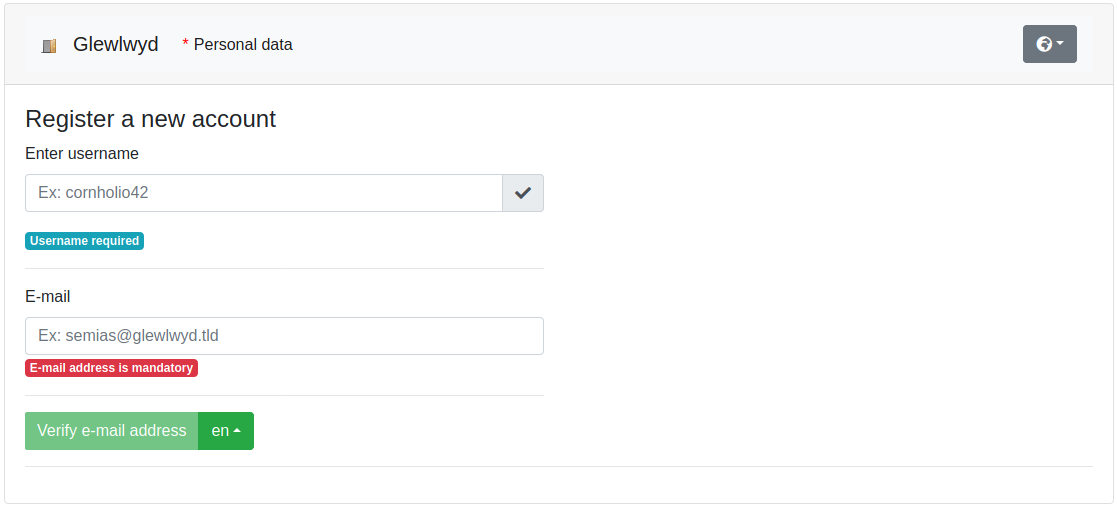
Use e-mail as username
Verify e-mail is checked and Username is e-mail is checked in the admin page of the plugin.
The new must verify its e-mail address to register, the e-mail will be used as the username, so it must be unused in the users list as username.

Enter personal data and register schemes if necessary
When the first step is complete, the new user must register one or more authentication method, such as choosing a password, registering an OTP, a TLS certificate, or a WebAuthn device.
A message below the screen will explain to the user the mandatory schemes the user must achieve to be able to complete its registration.
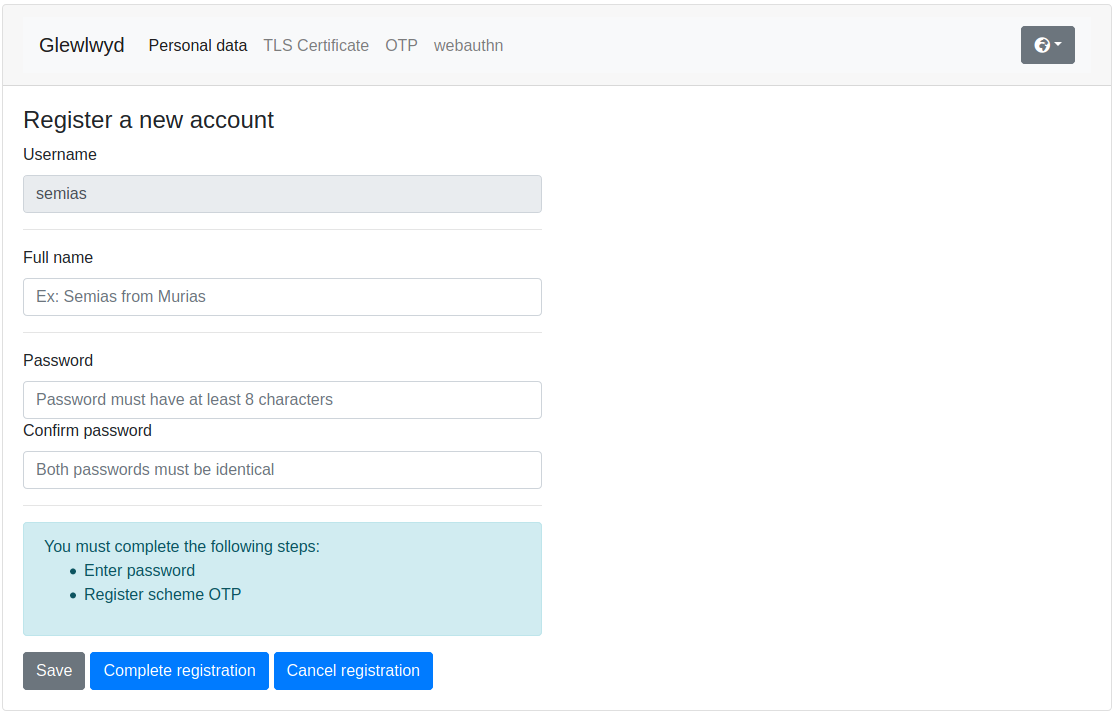
Cancel registration
The new user is allowed to cancel its registration before its completion. The user’s data and scheme registrations will be removed.
Complete registration
If all the mandatory steps are achieved, the new user can complete its registration.

Then it should be able to connect to Glewlwyd and the applications using Glewlwyd authentication.
Update e-mail process
If an existing user wants to update its e-mail address, it must validate the new address by clicking on a link send to the new address.
Note for registered users with their e-mail address as their username
This process will update the e-mail property only. If the user has registered through your Glewlwyd instance and the registration option Username is e-mail is set, the username will remain as the original e-mail address used to register.
Change e-mail
The change e-mail button is available in the profile page of the user.
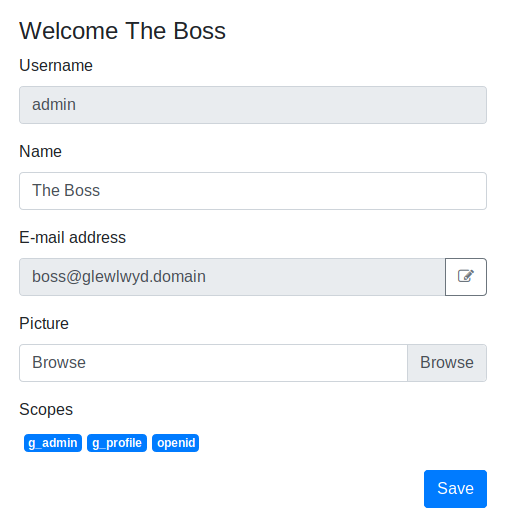
Enter new e-mail address
When the user clicks on the edit button right to the e-mail input in the profile page, an input modal opens up and asks the user to enter the new e-mail address. After clicking on the Ok button, an e-mail will be sent to the new address. In the e-mail, the user must click on the given link to validate its new e-mail address.
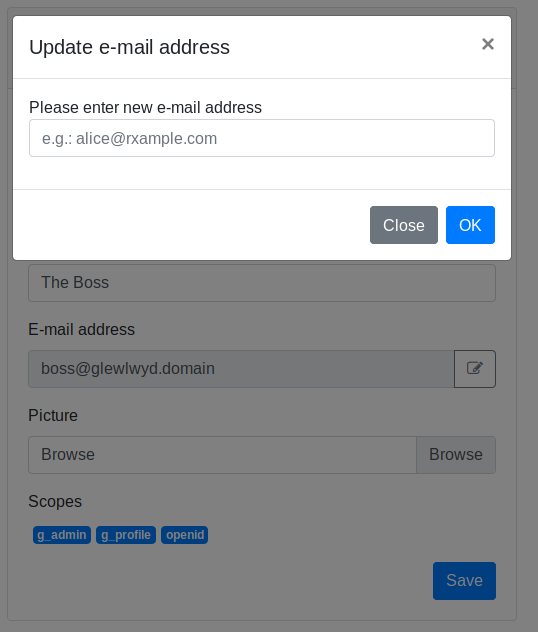
Reset credentials process
When a user has lost its credentials (password or authentication scheme) that forbids to log in Glewlwyd properly, it can start the reset credentials process to recover its account. To reset its credentials, the user can either receive a link via e-mail or use a previously generated recovery code.
Start the reset credentials process from the login page
In the login page, the user must click on the Lost credentials? button.

Then, the user must either enter its recovery code or send a link to its e-mail address. Depending on the reset credentials configuration, it can be only one method available to reset a user’s credentials.

Reset recovery codes in the profile page
The user can reset its recovery codes in the profile page in the Password tab. There, the user must expand the Reset credentials - Initialize recovery code accordion and click on the Reset recovery codes button. Then a modal window will appear containing new recovery codes. Then, the user must save this new recovery codes in a safe place to be able to recover its account.

Note that when a recovery code has been used to reset the user credentials, it will be disabled to avoid re-using a code more than once.
At any time, the user can ask for a new set of recovery codes.
Reset credentials page
Then, when the user has accessed its reset credentials page, it will be able to enter a new password and update or recover its scheme configuration if necessary.
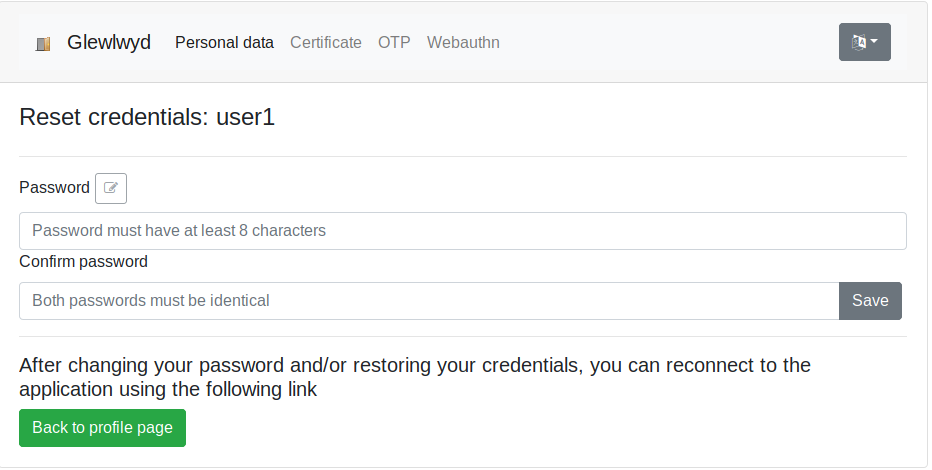
Register endpoints specifications
This documentation is intended to describe all the plugin endpoints behaviour.
Prefix
All URIs are based on the plugin name you will setup. In this document, all API endpoints will assume they use the prefix /api/register.
Get plugin configuration
URL
/api/register/config
Method
GET
Success response
Code 200
{
registration: {
set-password: string, values possible are 'no', 'yes' or 'always'
schemes: [ // Array of schemes available for registration
{
module: string, module type
name: string, module name
register: string, values possible are 'yes' or 'always'
display_name: string, display name for the module
}
],
verify-email: boolean
email-is-username:boolean
},
update-email: boolean
reset-credentials: {
email: boolean
code: boolean
}
}
Check username
URL
/api/register/username
Method
POST
Body Parameters
{
username: string, mandatory
}
Success response
Code 200
The username is available
Code 400
Username unavailable
Register a new user without e-mail validation
URL
/api/register/register
Method
POST
Body Parameters
{
username: string, mandatory
}
Success response
Code 200
The registration process has started.
A session cookie has been sent to the browser
Code 400
Username invalid or unavailable
Code 403
The new user must verify its e-mail address.
Send e-mail verification code
URL
/api/register/verify
Method
PUT
Body Parameters
{
username: string, mandatory if the username is different from the e-mail in the plugin configuration
email: string, mandatory
}
Success response
Code 200
The e-mail has been sent
Code 400
Error input parameters format
Code 403
The new user can’t verify its e-mail address.
Verify e-mail address
URL
/api/register/verify
Method
POST
Body Parameters
{
username: string, mandatory if the username is different from the e-mail in the plugin configuration and if token is missing or empty
email: string, mandatory if token is missing or empty
code: string, code verification, mandatory if token is missing or empty
token: string, token verification
}
Success response
Code 200
The e-mail is verified.
The registration process has started.
A session cookie has been sent to the browser
Code 400
Error input parameters
Code 403
The new user can’t verify its e-mail address.
Get current profile data
URL
/api/register/profile
Method
GET
Success response
Code 200
{
username: string, the username used to register
name: string or null
email: string or null
password_set: boolean
}
Code 401
Invalid registration session
Update password
URL
/api/register/profile/password
Method
POST
Body Parameters
{
password: string, mandatory
}
Success response
Code 200
Password updated
Code 400
Error input parameters
Code 401
Session invalid
Code 403
User is not allowed to change its password
Update user full name
URL
/api/register/profile
Method
PUT
Body Parameters
{
name: string or null, mandatory
}
Success response
Code 200
Name updated
Code 400
Error input parameters
Code 401
Session invalid
Can the user use the specified authentication scheme
URL
/api/register/profile/scheme/register/canuse
Method
PUT
Body Parameters
{
scheme_name: name of the scheme to check, mandatory
username: string, mandatory
}
Success response
Code 200
Scheme is registered for this user
Code 400
Error input parameters
Code 401
Session invalid
Code 402
Scheme is available but not registered for this user
Code 403
Scheme is unavailable for this user
Get scheme registration
URL
/api/register/profile/scheme/register
Method
PUT
Body Parameters
{
scheme_name: name of the scheme to check, mandatory
username: string, mandatory
}
Success response
Code 200
Get the scheme registration data. The response depends on the scheme.
See Authentication Scheme APIs
Code 400
Error input parameters
Code 401
Session invalid
Update scheme registration
URL
/api/register/profile/scheme/register
Method
POST
Body Parameters
{
scheme_name: name of the scheme to check, mandatory
username: string, mandatory
value: object, mandatory
}
Success response
Code 200
Scheme registration updated.
Depending on the scheme and the command, the response may also contain JSON data.
Code 400
Error input parameters
Code 401
Session invalid
Cancel current registration
URL
/api/register/profile
Method
DELETE
Success response
Code 200
Registration has been canceled
Code 401
Session invalid
Complete registration
URL
/api/register/profile/complete
Method
POST
Success response
Code 200
User has been successfully created
Code 400
Some authentication schemes must be registered to complete the registration
Code 401
Session invalid
Trigger update e-mail
URL
/api/register/update-email
Method
POST
Security
The user must use a valid profile session cookie
Body Parameters
{
email: new e-mail to verify, mandatory
}
Success response
Code 200
Link sent to the new e-mail address.
Code 400
Error input parameters
Code 401
Session invalid
Verify updated e-mail
URL
/api/register/update-email/:token
Method
PUT
URL Parameters
token: token used to verify the new e-mail, mandatory
Success response
Code 200
User profile updated with the new e-mail address.
Code 403
Token invalid
Get current profile data (reset credentials)
URL
/api/register/reset-credentials/profile
Method
GET
Success response
Code 200
{
username: string, the username used to register
scheme: [
{
module: string, type of scheme
name: string, identifier of the scheme
}
]
}
Code 401
Session invalid
Update password (reset credentials)
URL
/api/register/reset-credentials/profile/password
Method
POST
Body Parameters
{
password: string, mandatory
}
Success response
Code 200
Password updated
Code 400
Error input parameters
Code 401
Session invalid
Code 403
User is not allowed to change its password
Can the user use the specified authentication scheme (reset credentials)
URL
/api/register/reset-credentials/profile/scheme/register/canuse
Method
PUT
Body Parameters
{
scheme_name: name of the scheme to check, mandatory
username: string, mandatory
}
Success response
Code 200
Scheme is registered for this user
Code 400
Error input parameters
Code 401
Session invalid
Code 402
Scheme is available but not registered for this user
Code 403
Scheme is unavailable for this user
Get scheme (reset credentials)
URL
/api/register/reset-credentials/profile/scheme/register
Method
PUT
Body Parameters
{
scheme_name: name of the scheme to check, mandatory
username: string, mandatory
}
Success response
Code 200
Get the scheme data. The response depends on the scheme.
See Authentication Scheme APIs
Code 400
Error input parameters
Code 401
Session invalid
Update scheme (reset credentials)
URL
/api/register/reset-credentials/profile/scheme/register
Method
POST
Body Parameters
{
scheme_name: name of the scheme to check, mandatory
username: string, mandatory
data: object, mandatory
}
Success response
Code 200
Scheme registration updated.
Depending on the scheme and the command, the response may also contain JSON data.
Code 400
Error input parameters
Code 401
Session invalid
Trigger reset credentials via e-mail
URL
/api/register/reset-credentials-email
Method
POST
Body Parameters
{
username: username to reset credentials
}
Success response
Code 200
Link sent to the corresponding e-mail address.
Code 400
Error input parameters
Code 401
Session invalid
Verify reset credentials e-mail
URL
/api/register/reset-credentials-email/:token
Method
PUT
URL Parameters
token: token used to verify the reset credentials, mandatory
Success response
Code 200
A cookie session for the reset credentials process
Code 403
Token invalid
Reset recovery codes
URL
/api/register/reset-credentials-code
Method
PUT
Security
The user must use a valid profile session cookie
Success response
Code 200
[
"code1",
"code2",
...
]
Code 401
Session invalid
Start a reset credentials session by verifying a recovery code
URL
/api/register/reset-credentials-code
Method
POST
Body Parameters
{
username: username to reset credentials
code: valid recovery code
}
Success response
Code 200
A cookie session for the reset credentials process
Code 403
Code invalid
